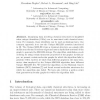Free Online Productivity Tools
i2Speak
i2Symbol
i2OCR
iTex2Img
iWeb2Print
iWeb2Shot
i2Type
iPdf2Split
iPdf2Merge
i2Bopomofo
i2Arabic
i2Style
i2Image
i2PDF
iLatex2Rtf
Sci2ools
DILS
2005
Springer
2005
Springer
Assigning Unique Keys to Chemical Compounds for Data Integration: Some Interesting Counter Examples
Integrating data involving chemical structures is simplified when unique identifiers (UIDs) can be associated with chemical structures. For example, these identifiers can be used as database keys. One common approach is to use the Unique SMILES notation introduced in [2]. The Unique SMILES views a chemical structure as a graph with atoms as nodes and bonds as edges and uses a depth first traversal of the graph to generate the SMILES strings. The algorithm establishes a node ordering by using certain symmetry properties of the graphs. In this paper, we present certain molecular graphs for which the algorithm fails to generate UIDs. Indeed, we show that different graphs in the same symmetry class employed by the Unique SMILES algorithm have different Unique SMILES IDs. We tested the algorithm on the National Cancer Institute (NCI) database [7] and found several molecular structures for which the algorithm also failed. We have also written a python script that generates molecular gr...
| Added | 14 Oct 2010 |
| Updated | 14 Oct 2010 |
| Type | Conference |
| Year | 2005 |
| Where | DILS |
| Authors | Greeshma Neglur, Robert L. Grossman, Bing Liu |
Comments (0)

